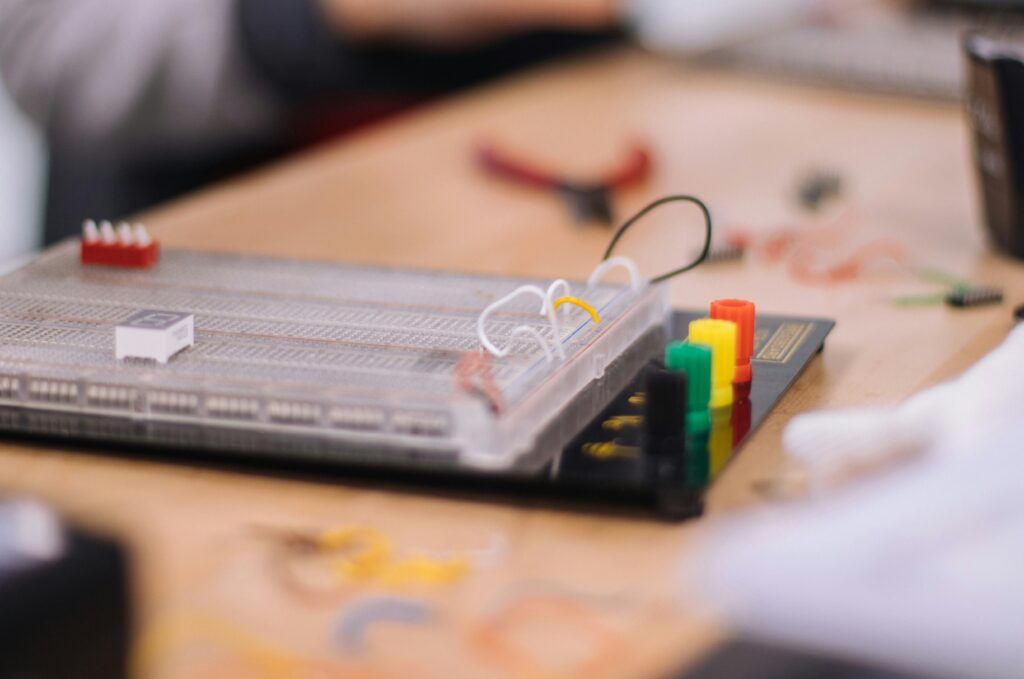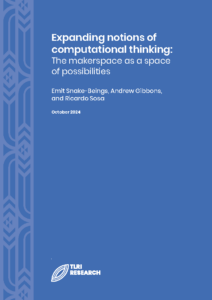1. Introduction
The New Zealand Digital Technologies and Hangarau Matihiko curriculum, introduced in 2017, draws attention to the teaching of computational thinking skills for all learners. The curriculum reinforces that computational thinking skills are essential skills for life, employment, and industry and that these can and should be taught in dedicated digital technologies programmes. At first glance, this approach to the curriculum seems reasonable. Computational thinking is generally accepted as belonging to the computer sciences because it enables learners to communicate with computers by understanding how computational processes work—thinking that becomes good computer programming. However, as we look more deeply at the literature, we can see that there are more diverse discussions of computational thinking, and that computational thinking occurs beyond the confines of the computer sciences and learning to program (Bell & Lodi, 2019; Hershkovitz et al., 2019; Iversen et al., 2018; Jenkins, 2017; Kafai, 2016; Kules, 2016; Rode et al., 2015; Tissenbaum et al., 2019).
Many of these wider occurrences of computational thinking appear to resonate with the work that emerges in school makerspaces: “Makerspaces are places where participants may work together to create and co-create knowledge and physical or digital products. A making environment provides the potential for cross-curricular connections, collaboration, creativity, innovation, and learning” (Mersand, 2021, p. 175). Makerspaces are highly participatory, promote open-ended discovery and personalised learning, and recognise collective ability rather than hierarchies of expertise (Hatch, 2017; Lachney & Foster, 2020). In addition, much of these wider experiences resonate with contemporary observations from the science of learning research which reveals the importance of recognising the social and cultural contexts of the learner–teacher–curriculum relationship (see, for instance, Darling-Hammond et al., 2020).
There is a difference between what is popularly known as computational thinking in a computer sciences curriculum and the sorts of computational thinking seen in the more practical and intentionally collective activities of the makerspace (Hadad, 2020; Juškevičienė, 2020). These differences are well encapsulated by an observation from Seymour Papert, a leading researcher in education and digital technologies, that computational thinking was far too often taught from the “cookbook”. His concern was that computational thinking taught from a cookbook had the effect of limiting rather than expanding thinking (Papert, 2000). Guided by this observation and by evidence of the kind of thinking and making that appears to be valued and practised in makerspaces, we asked the research question: How does a makerspace contribute to expanded notions of computational thinking?
Our research team grew from an existing partnership between Manurewa High School and Auckland University of Technology’s Schools of Design and Education. Previous collaborations explored design thinking, robotics, citizenship, and social justice in the classroom (Sosa, 2022). That collaboration led to the formation of a team immersed in the creative approaches and work of the Makerspace community, providing making and researching activities that supported ongoing projects driven by students’ interests and aspirations.
At Manurewa High School, the Makerspace provides a setting, resources, and a team for during and after school formal and informal making projects. For this project, we worked with a weekly after-school group. The Wānanga Wednesday after-school group brings together students from all years in the school, working alongside teachers and community members experienced in making, in digital technologies, and in entrepreneurship. Students work on projects driven by their own interests and aspirations.
Working alongside students, developing relationships, and honouring the Makerspace ethos of whanaungatanga and student leadership, the research collaboration allowed us to see and take part in the interests and enthusiasms of the students. We observed, discussed, and contributed to the making occurring in the Makerspace as members of the weekly Makerspace work. The space features many of the digital tools of technology associated with makerspaces, such as laser cutter, 3D printer, and CNC milling machines (see, for instance, Hatch, 2017). Importantly, the environment of the Makerspace also features posters throughout the space that affirmed the voluntary and collaborative ethos of maker culture.
The ethos of the Makerspace differs from a cookbook of prescribed curriculum programming and planning in many ways. In the Makerspace we saw the potential of student-led constructions of the learning environment, supported by the social contexts of the learning space. A focus on the learners leading within their community contexts contrasts with a teacher-centred and/or programme-centred method of instruction of computational thinking in the computer sciences, because it involves a wider and more diverse leadership model drawing on collaboration and collective responsibilities for the learning and the learning environment. A focus on construction is, in this research, more than a focus on what gets made in a makerspace, it’s a focus on the culture of thinking that occurs in the space.
The idea of constructionism, in this project, has been influenced and adapted from Seymour Papert (1980, 1993) and Sherry Turkle (2005, 2011) to illustrate the practical use of the idea within the makerspace. We drew from the constructionist focus on the social and relational, as well as the hands-on, and open-ended dimensions of computational thinking. It was back in 1980 that Seymour Papert recognised that technology-focused teaching tends to disregard the social values and learning strengths of intuitive hands-on practices. Papert was hence drawing attention to the risk of approaching and implementing technology in the classroom following conventional pedagogies that tend to disregard “powerful ideas” (Papert, 1980) that are valued and encouraged in the makerspace. As already noted above, Papert lamented: “everyone is too busy following the cookbook” (p. 139). Fast forward to the 21st century and we can still see, in the research literature, a concern that the teaching of computational thinking is limiting when it is located only within the computer sciences (Bell & Lodi, 2019; Grover & Pea, 2013), particularly where curriculum follows a predetermined set of instructions, and involves developing skills of writing precise and unambiguous instructions that computers can understand.
So, Papert would still be lamenting that computational thinking is still too narrowly understood and lacked “power”. Our project draws on “powerful ideas”, a key concept present in the title of his influential book (Papert, 2000) to identify the complexity of makerspace engagements with knowledge in an intensely collaborative expansion of computational thinking. This understanding is supplemented by the idea of “Dialogic Learning” from the work of Paulo Freire (1993). In prioritising dialogic learning, “the teacher-of-the-students and the students-of-the-teacher cease to exist and a new term emerges: teacher-student with students-teachers” (Freire, 1993, p. 80), leading all to “become jointly responsible for a process in which all grow” (p. 80).
Teaching computational thinking has largely centred on STEM areas (i.e., the computer sciences, technology, engineering, and mathematics subjects) (Grover & Pea, 2013). While the broader technology curriculum does recognise that computational thinking is typically integrated into other curriculum learning areas (see, for instance, Ministry of Education, 2018), this integration is expected to occur in Years 1–8 and not during the secondary school years. More importantly, even where integrated, any integration is limited by the articulation of the nature and purpose of learning programming (although not without objections from the digital technology industries (see, for example, Gibbons & Kupferman, 2019). Abstraction, decomposition, and algorithmic thinking are all recognised traits of computational thinking within the curriculum. For early childhood, primary, and secondary school students, computational thinking typically includes abilities to solve problems through logical organisation of data, abstraction through models and simulations, algorithmic thinking to automate solutions, and the construction of efficient and effective steps to problem solving (Sykora, 2021).
Bell and Lodi (2019) question a narrow curriculum framing of computational thinking. They ask whether computational thinking should be situated exclusively within the computer sciences, and they recommend more inclusive, expansive, and accessible strategies for teachers and learning communities who wish to develop the wider, social aspects of digital literacy.
In the study of wider and diverse theories and practices of computational thinking, we can see immense possibilities for computational thinking and the engagement of the learner throughout the curriculum. These theories and practices include: computational participation (Kafai, 2016); computational making (Rode et al., 2015); computational action (Tissenbaum et al., 2019); computational empowerment (Iversen et al., 2018); computational creativity (Hershkovitz et al., 2019); critical thinking and computational thinking (Kules, 2016); constructionism and computational thinking (Csizmadia et al., 2019); and dialogic learning and computational thinking (Jenkins, 2017). Each of these expansions of computational thinking resonates with the ethos of the makerspace and its focus on social and embodied construction rather than instruction.
Instruction, as a teacher-led learning practice, has the implications of a centralised curriculum, whereas student-initiated construction of a learning space implies what Sherry Turkle and Seymour Papert call “epistemological pluralism” (1990): multiple ways of knowing and learning through a configuration of projects, peers, and passion (Lachney & Foster, 2020). Epistemological pluralism is a vital and productive concept for teachers and learners in a complex world. This attention to the diversity of modes of knowing that are present in all learning communities (classrooms, early childhood centres, and beyond) resonates with the most recent research on the science of learning and the relationship between context and learning outcomes (see, for instance, Darling-Hammond et al., 2020). The resonance between computational thinking, makerspaces, and epistemological pluralism reflects the influence and strength of Papert’s contribution to the study of learning and teaching—an important observation from the historical development of the makerspace in which learners follow individual pathways and processes, with practical and applied experimentation, and within social contexts (Lachney & Foster, 2020).
The need for empirical inquiries in computational thinking across the curriculum has been clearly identified in the literature for over a decade (Grover & Pea, 2013). Within the context of this apparent need, it is important to emphasise a diversity of contexts for computational thinking. For example, there has been little research on what computational thinking may look like for the wider humanities in the next few decades (Tedre & Denning, 2016).
This project is committed to this expansion of computational thinking within and beyond the context of the makerspace and the associated elements of maker culture. We explore what occurs in the Manurewa Makerspace as “advanced computational thinking”, or ACT. We are particularly interested in how ACT occurs for students when working with both digital and non-digital technologies within the makerspace, as a space of possibilities. This focus, we believe, offers a way to engage with expanding notions of computational thinking across all learning areas, and in the many informal as well as formal moments of a school or early childhood centre day. We have developed and used the term “ACT” to suggest that the way forward is to bring in a wider, and plural, understanding of thinking, computation, and computational thinking, drawing on the nuances and the values we observed at Manurewa Makerspace.
2. Research design
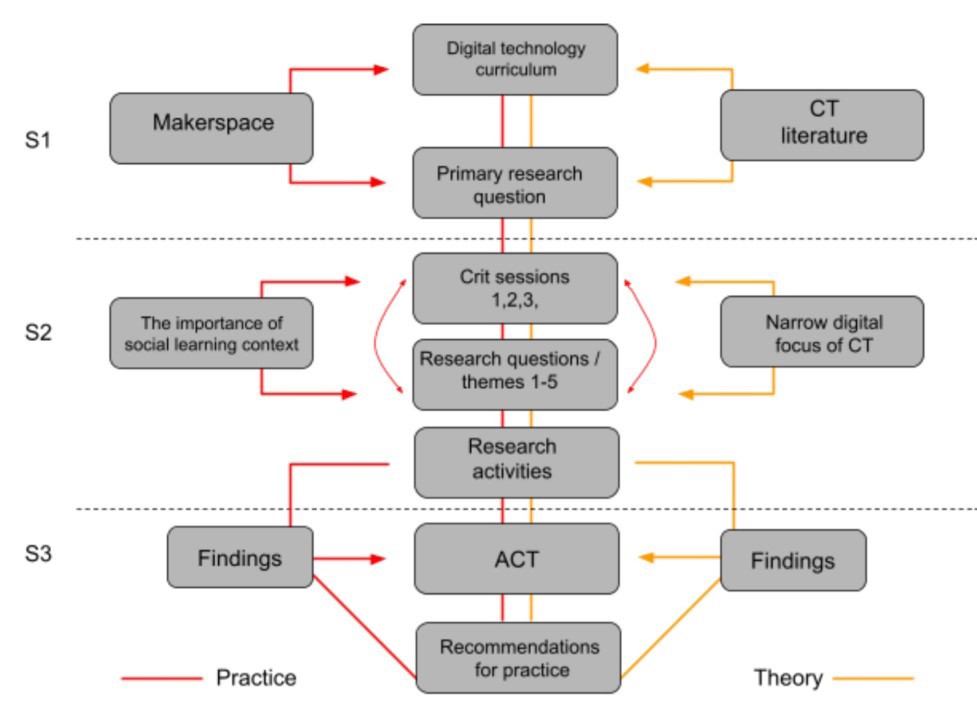
In stage one of the research (S1 of Figure 1 above) we were interested in developing a primary research question based on what we perceived to be the gaps between a theoretical understanding of computational thinking, based in the computer sciences, and experiences with the students at the Makerspace: working with both digital and non-digital technologies. With a member of the research team participating on a weekly basis in Wānanga Wednesday, we observed a wide variety of ways that students used tools to support their individual and collective thinking—the students were engaged in expanded practices of computational thinking. In other words, they were engaging in ACT. Therefore, the primary research question was concerned with “advancing” ideas of computational thinking to include many of the wider factors we had observed in the Makerspace:
How do students and teachers experience engagement with an advanced level of computational reasoning that prioritises ethical, creative, critical, reflective, and community dimensions?
In the second stage (S2) of research (Figure 1), we initiated a series of three “crit sessions” to find out more details about the “ethical, creative, critical, reflective, and community dimensions” of the learning environment at the Makerspace. This was a circular research design, a dialogue, whereby research themes and questions emerged from the activities of the crit sessions. A crit session is a practice used in design schools and design thinking, where learners meet in an informal space for open discussion and dialogue in relation to a design project or practice: an exchange of ideas and improvements that shapes the culture of feedback characteristic of design studios. The dialogical aspects of the crit sessions, with a focus on peer-review, encouraged questions and prompts from the students which emerged during the process.
At this second stage of research, we placed two initial hypotheses in contrast to each other: that computational thinking was narrowly based in the digital realms and that there was a social dimension to learning (observed in the weekly Makerspace sessions) which could provide a wider context for more expansive and collective computational thinking. We identified research questions/themes that emerged from the dialogues of the crit sessions:
- What drives and motivates the students?
- What are students’ attitudes to digital technology?
- How do students view creativity in this area?
- How do students work and learn together?
- What are the paradoxes of practice?
Still in the second stage of the research, we designed a variety of research activities to address different aspects of computational thinking theory and makerspace practice (see more detailed descriptions below) to generate a series of findings that were analysed in the third stage of the research (S3, Figure 1); organised through the five research themes. In the process, we developed a sense of what ACT may look like.
The timeline of the various research activities is shown in the table below (Table 1): divided into the three periods of milestone reports with analysis occurring across the research timeline through weekly discussion sessions.
Research activities timeline

As can be seen in Table 1, weekly visits to the Makerspace and the literature review predate the start of the research and several of the activities carry on beyond the end of the final milestone report since these are research activities that have resolved into research outcomes: ACTivities Handbook, website and podcasts, and the forthcoming Access Journal special edition. The production of the ACTivities Handbook provided an opportunity to both focus on practical approaches to advanced computational thinking in the classroom, and a reflective tool to engage in the cycles of analysis and theorisation of the observations from the thinking workshop, the crit sessions, and the weekly observation and participation in the Makerspace alongside the students.
Crit sessions
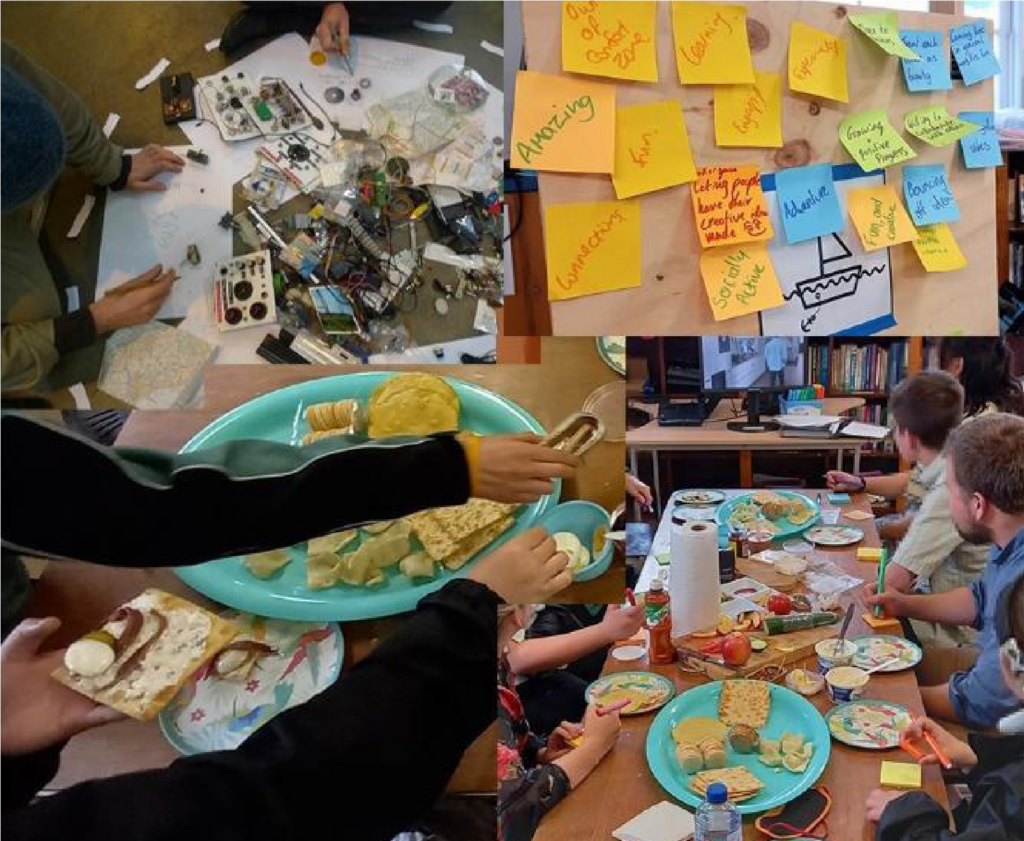
The crit sessions were offered as a relaxed series of data gathering events during Wānanga Wednesday. The members of the Makerspace whānau were invited to flow between their work and the crit session. The emphasis in these sessions was to collectively examine the learning experience in the Makerspace and in connection to developing a more advanced idea of computational thinking.
The first of three crit sessions involved critiquing a standard computational thinking exercise: listing all the stages necessary in making a sandwich, breaking down the stages into a series of instructions that a computer would be able to follow. Traditionally, this exercise is directed towards developing the skills of computer coding, identifying all of the steps needed to instruct a computer program to “build a sandwich”. In this crit session, crackers were made and shared, the students were prompted by videos of robots making food with discussions exploring the use of robotics in different contexts of meal manufacturing. We explored elements that were “outside” of an ideal computational thinking solution to the problem: to include some of the things that programmers might have forgotten, had taken for granted, or just simply were not within the scope of digital technology (e.g., the instruction “add salt to taste” became meaningless if a digital computer didn’t have a sense of taste); also, improvisation and the trying of new combinations of food based on past experiences was seen as lacking immediacy when performed by a robot.
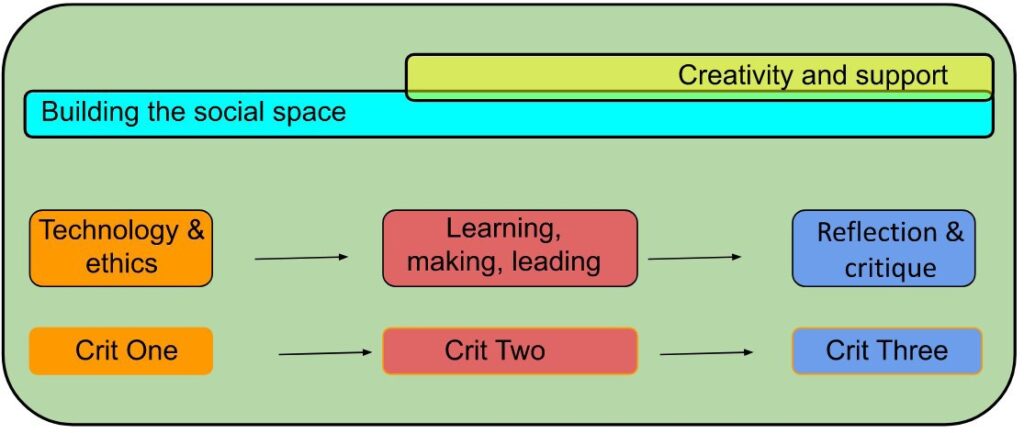
The themes of the crit sessions are displayed in Figure 3, showing the aspects of “building the social space” and “creativity and trust” with an overlap in Crit Two which was based on generating ideas to evaluate the role of student leadership within the Makerspace. Session 2 also delved into students’ views on successes and challenges in the Makerspace:
- What was important for learners to encourage them to take initiatives?
- What did students feel were the necessary steps and requirements needed?
- What were the individual and collective successes of the Makerspace?
Questions concerning learners’ participation in the makerspace (reasons for joining, favourite technologies, things they could change, skills they learnt, inspirations for projects, and changing beliefs), were explored alongside opportunities for studentdriven leadership in the makerspace. In the third crit session, learners explored methods to reflect on their own creative processes and to critique each other’s work in ways that maintained a convivial social space, supporting further risk-taking aspects of creativity through a sense of trust and support. The aim of the third crit session was to build on the observations and discussions of the first two crit sessions in order to focus on the making practices students engaged in individually and collectively.
Transdisciplinary Thinking Workshop
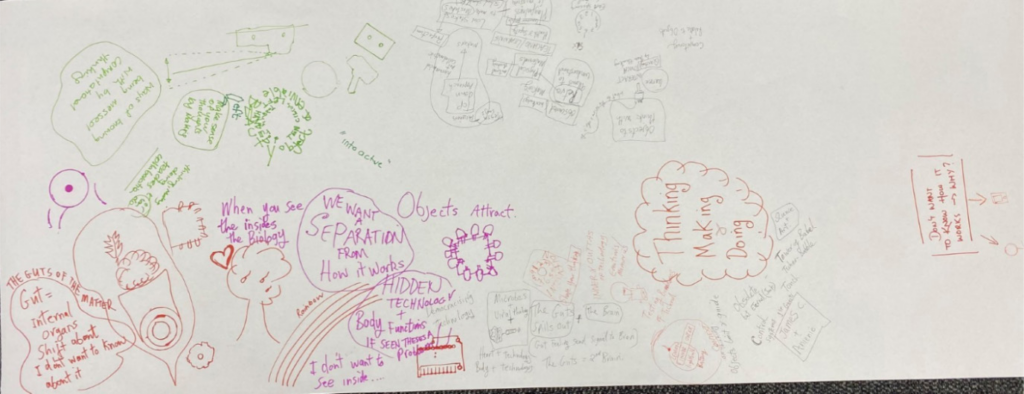
The meaning of thinking is somewhat overlooked in research on computational thinking—almost as if “thinking” is unnecessary in the term “computational thinking”. The data gathering and analysis led us to recognise the importance of bringing thinking back into view. So, the Transdisciplinary Thinking Workshop was devised and run.
The Workshop involved 22 participants from a wide range of disciplines and fields. The aim of the thinking workshop was to explore how expanding thinking might contribute to expanding computational thinking. Participants in the workshop explored thinking as situated and defined by a particular context, and to explore how computational thinking, situated within a makerspace, differs in our reading of the emphases in the Digital Technologies curriculum. The World Café method (2022) was adapted for the purpose, with five themed tables providing an informal and relaxed environment for exchanges of experiences, insights, and discussions. Five tables were organised, with the following themes:
- Definitions of thinking
- Traditions and hierarchies of thinking
- Thinking, making, and doing
- Thinking and inequity
- Technological disruptions and thinking.
ACTivities Handbook
The ACTivities Handbook, produced in collaboration with Adam Ben-Dror, Chris
Berthelsen, Xin Cheng, Rumen Rachev, Emit Snake-Beings, Ricardo Sosa, and Andrew Gibbons, was a research activity and outcome that brought together teachers and practitioners from the wider local “maker” community. As both research activity and research outcome, the process of making the handbook was a dialogue on the various strategies of introducing and expanding concepts of computational thinking that are “unplugged” (see for instance Munasinghe et al., 2023). The central design of the ACTivities Handbook evolved as:
- Activities that did not need any specific materials or tools
- Could be done in a variety of classrooms, workshops, indoor, or outdoor spaces
- Explored ways of engaging in computational thinking without the need of digital technologies.
Website and podcasts
The podcast series, presented as a research outcome on the ACT website (www.advanced-ct.space), is an ongoing series of discussions amongst members of the research team. The dialogical research design is organised around topics connected with the research themes, as a series of conversations to stimulate talks and discussions on elements of ACT and how to bring ACT into the classroom, early childhood centre, and beyond. The conversations include ideas for practical projects and activities. Beyond the practical dimensions of teaching and learning, the podcast dialogues also explore the connections between the digital technology curriculum, the challenges faced by curriculum designers to keep up with technology, a commitment to introduce more critical questioning of what “advanced” might mean, and an exploration of how social learning contexts can be included within computational thinking-based activities.
Method of analysis of findings
Analysis, in stage three of the research (see S3 Figure 1), compared theoretical findings from the literature on computational thinking with the practice-led findings we had gathered with the students at the Makerspace, the field notes from weekly participation in Makerspace sessions, the ACTivities Handbook, the thinking workshop, and the podcast dialogues. Findings were organised around the five research questions and sub-themes that emerged during the research.
The weekly interactions with the Makerspace allowed the research team to reflect on and collectively make sense of the rich data (Ardoin et al., 2014; Elsbach & Flynn, 2013; Gray, 2014) that emerged from the participant observations. The study enabled data to be interpreted, tested, and validated through cycles of collection and analysis (Brennan & Resnick, 2012; Lui et al., 2019). Themes that emerged formed into questions that propelled us back into the data. Themes were woven together across studio observations, crit sessions, and debriefs, slowly building a picture of the Makerspace as a space of possibilities that resonate with the wider conceptualisations of computational thinking explored in the literature, designed in the handbook, and discussed in the podcasts and workshop.
3. Key findings
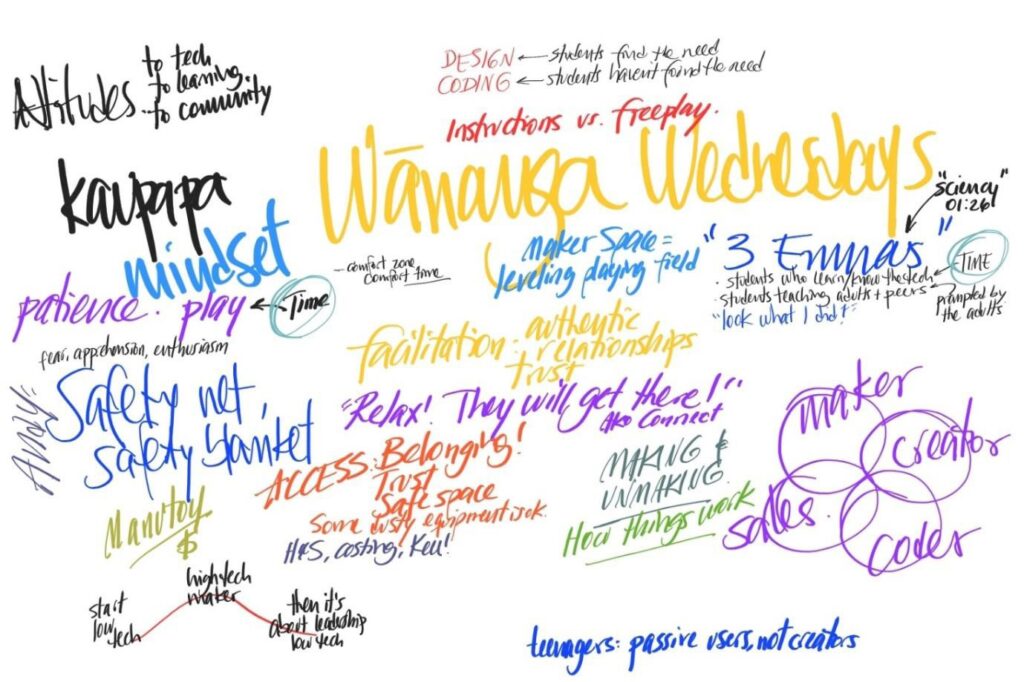
The key findings below are organised as five research questions that emerged during the time spent interacting at the Makespace, during the crit sessions, handbook design, podcast production, and thinking workshop.
1. What drives and motivates students?
- Shared environment
- Shared food
- Belonging
- Shared knowledge.
In the crit sessions, discussions with the students emphasised the central function of “making” as motivated by the growth of relationships, the freedom to explore, and the enjoyment of fulfilling tasks in a shared environment. The needs of students for a shared space were expressed in terms of:
- To “treat each other as family”
- A space to work and belong
- A willingness to collaborate
- Where all “newbies” were welcome.
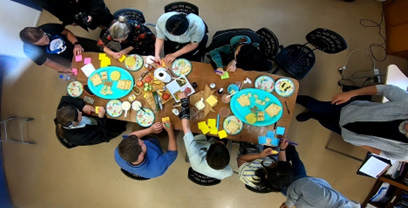
Shared food was an important part of building the learning community, observed from our weekly interactions that students had actively initiated and maintained the practice of shared food from the early days of the Makerspace. Sharing food generated a sense of belonging that enabled deeper responsibilities for student-led learning; to “feel at home” and be “familiar” with the technology, where peer-support provided a context for learning.
We found key driving forces for the students were:
- The people
- The technology • The shared activities
- The space.
In Crit Session 2, some of the key words for students’ motivation were:
- Connections
- Fun
- Engaging
- Adventure
- Experimenting
- Social.
We found that the space was defined by both social and technological expectations which focused on the sharing of knowledge and skills. The emphasis that students placed on the social aspects of learning tended to make equipment such as the laser cutter and 3D printer very popular, gaining knowledge collectively, rather than diversifying technical skills across a wide range of technologies. In this sense, expertise within the Makerspace tended towards collective shared knowledge rather than individual knowledge or skills. In the same sense, the expectations of a traditional student–teacher relationship were also challenged by the learning community; the teacher was part of the collective knowledge base from which students could learn and was cognisant of their own journey as a learner in the Makerspace.
2. What are students’ (and teachers’) attitudes to digital technology?
- Technology is not for me
- We think through feeling, seeing, figuring, being, doing, making
- Social context is important.
In a review session with the teaching team, one participant spoke about a memory of the “stink” of the science lab. This humorous observation opened productive discussions about how visceral the classroom spaces are for the learners, and how “gut feelings” impact on their interest and ability to engage with digital technology. This was a reminder that, for many learners, computational thinking had similar visceral reactions that impact on engagement.
In general, students demonstrated an attitude to technology that included a tolerance to making errors, an acceptance of the imperfections, encouraging a positive outlook towards technology. However, we also noted that digital technology that involved coding was far less “forgiving” than the materials and tools that students preferred to engage with.
In conversations during the crit sessions, we found that students were concerned with technology’s lack of connection with the sensory aspects of the material world. For example, the food robot has no sense of taste, demonstrating an attitude to technology that sought a more visceral, sensory, socially situated context. Likewise, discussions in the Transdisciplinary Thinking Workshop revealed tensions in technologically bounded ideas of “thinking” and an interest in the possibilities of thinking beyond “computation”, as defined by what a computer can traditionally do. Discussions and conversations brought up the idea that an emphasis on a narrowly defined “thinking” part of computational thinking runs the risk of excluding many rich ideas, such as computational figuring, computational feeling, computational making, computational organising, computational creativity, and computational sensing.
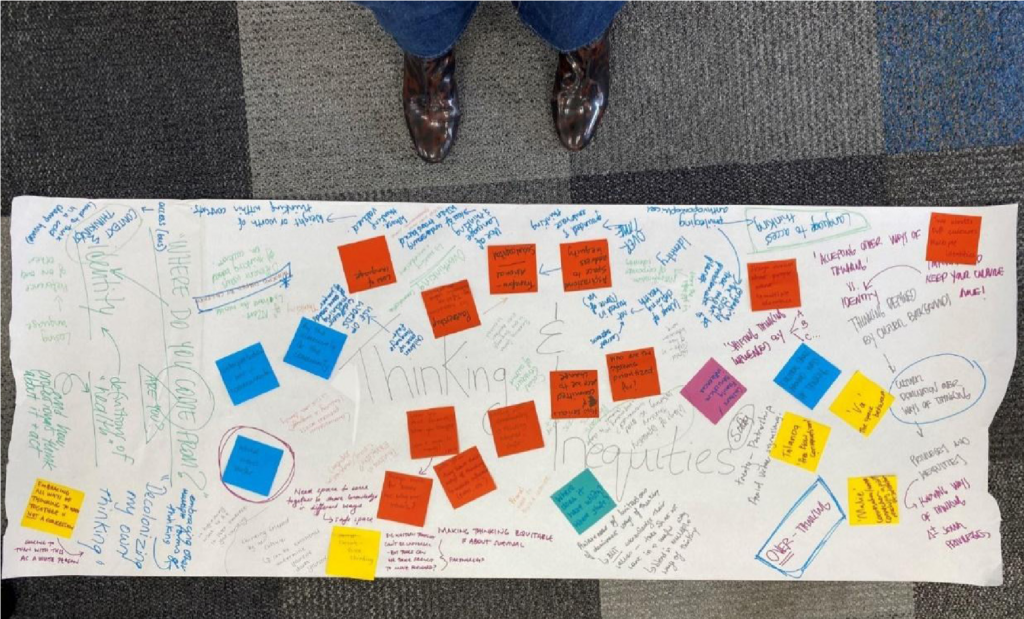
The dialogues recognised that sensory and social fields are all spheres in which computers are increasingly encroaching (e.g., the internet of things, voice recognition, AI, and art robots), and yet computational thinking constrained “thinking” as excluding these wider areas of experience. By using the term “thinking” in too narrow a sense, we are in danger of limiting the potentials of both computation and thinking. These ideas were expanded in the view expressed that thinking combines and obscures processes that include “feeling”, “seeing”, “figuring”, “being”, “doing”, and “making”; whereby thought is seen as a more rational, and therefore valued, cultural activity that is separated from the less valued thinking/knowledge which emerges from material “hands-on” activities. Findings challenged the idea that thinking is separate from the more physical activities of making and doing.
We discussed that materials, objects, and things offer the potential for “tangibility”, “fiddling”, “physicality”, “spontaneity”, “playful”, “agency for our thoughts’”, and that making involves a “dialogue with materials” from which abstract ideas as well as more concrete forms have the potential to emerge: thinking in-the-world (or through the objects in the world) was signalled as supportive of an understanding of the “deeper aspects of how the world works”.
Attitudes to technology played a significant role in developing ideas of ACT. In crit sessions, students demonstrated a critical approach to technology, questioning the limitations of food-making technologies. These questions included: the limitations of robotic and computational taste; limitations in deviation from a prescribed menu; an inability to experiment; and of not learning from mistakes due to lack of sensory information (“it might taste bad” but the robot would never know). Students debated whether having a robot follow a cookbook to make food was of less value than the social interaction of allowing people to choose from a variety of ingredients and share their improvised recipes amongst friends in a social context. This led to the discussion that the digital technologies of robots were much more dependent on human oversight than first imagined; for example, how does a robot gauge a successful meal, a valuation that requires complex human-based sensory feedback. Effectively, the students questioned the authenticity of the work of robotics in producing meals that revealed the social contexts of technology they felt were important. They also showed concern for the degradation of cooking skills if machinery replaced humans in meal production and considered that the whole point of such technology would be social, such as “making more time to spend with family”.
3. Views of own and others’ creativity
- Supportive social space needed for risk taking and creativity
- Creativity comes from process of working together
- Creativity occurs through a social process of “bouncing ideas around”.
We observed at the Makerspace that creativity was seen as a risk-taking activity—part of the adventure, encouraging students to respond to each other’s work with positive affirmations, as well as the occasional provocation when deemed appropriate. Observed through our weekly interactions at the space we saw that feedback from the students on each other’s designs contributed to a collective courage to explore the technology in the Makerspace. Knowledge was freely shared so that other students could realise their own creativity: sharing knowledge with regards to fixing technical issues (for instance, jammed machinery); technological and scientific principles essential to design (e.g., mathematics, measurements, and lever mechanics); as well as design practices (prototyping) and business and communication strategies to sell their creations (online marketing and monthly school markets). In this way, creativity was seen as part of processes including improvisation, risk taking and ongoing adjustments to planning, creativity as an ongoing process, aided by the social process of “bouncing off ideas” between each other.
4. How do students work and learn together?
- Building the culture of the space (the first task)
- the making of the “B safe space”
- Everyone is a learner.
Crit Session 2 found that keeping the space “open to newbies” was part of a larger “welcoming culture” to all learners that increased the dynamics of social interaction. We found that “building the culture” of the space meant that the Makerspace had the potential to be a cultural-pedagogical space nurtured by both students and teachers.
Asking students to identify positive experiences and challenges that they associated with their participation in the Makerspace (Crit Session 2), we found that confidence was seen to grow from the building of the “B safe space” (a project developed by the students and displayed on one of the walls of the Makerspace involving student-led guidelines for respectful interaction and acknowledgement of each other’s differences).
We observed an expectation that “everyone was a learner”, including the teachers in the space. Teachers ceased to see themselves as “experts”, whilst learners, driven by their interests and fuelled by supportive social surroundings, increasingly assumed the role of assisting others in the space.
5. What are the paradoxes of practice?
- Accepting contradictions in an epistemologically plural learning environment
- Advanced technology: is it really better and for whom is it better?
- The problems of regular school assessment restricting time spent at the space.
One of the themes we encountered in our weekly visits to the Makerspace was what we recognised as a form of epistemological pluralism emerging through student-led ctivities. Epistemological pluralism, a recognition of multiple ways to learn through participation, discussed in the introduction of this research report, was seen to emerge from the rich social relationships. We observed that the activities of the Makerspace, focused on materials, allowed the development of pluralistic approaches to learning due to the unique nature of each of the students’ projects.
A key part of the widening and blurring of teacher/student role models was the absence of the external pressure of grading. In the Makerspace Wānanga Wednesday, assessment is collective and formative, allowing students to take more risks in following their own learning strengths, contributing to the shared knowledge of the community of learning. However, not grading work in the Makerspace did provide a limitation, in that students then have to prioritise study for conventional assessments.
In discussions on the design process in the Makerspace we recognised a range of design experiences and practices that reflected elements of the Digital Technology curriculum, including the exploration of material properties, and how systems work. In these practices, we recognised that a disposition to hold paradox, accepting that there are multiple ways to learn which can sometimes be contradictory, reveals an acceptance of contingency and complexity. We found that it was not always possible to create or learn something new without planning, and yet students also needed to make deviations from the plan to follow emergent, unexpected, complex materials processes that they encountered along the way. Flexibility was an essential part of the working processes we observed in the Makerspace. The type of thinking we observed in the Makerspace allowed for multiple, and even conflicting, ways of learning to be expressed, leading to the conclusion that it was not always possible to plan for every unforeseen consequence in the process of making. This paradox expands when thinking about the paradox of human-technology interaction.
In Crit Session 1, students engaged in discussion of the pros and cons of a range of robotic innovations. Each of the examples elicited observations of benefits and limitations indicating a capacity to differentiate elements of coding and robotics—a robot making food could be “cool” and “fun” and even “revolutionary”, but students questioned the social values of such a meal. A fundamental question arose from the students: if technology is advanced, is it really better? What is it that we lose in terms of social connections and time spent with others?
4. Recommendations for practice
The social space: Dialogue, leadership, and shared inquiry
The community dimension of learning spaces has been a major aspect of the findings in this research. To get the most out of expanding computational thinking, we recommend a situated learning approach where pedagogy is based on dialogue and shared inquiry. In this sense, the social context of learning is extremely important (Findings, Section 2). The first task of learners and teachers is “Building the culture of the space” (Findings, Section 4): a space where a collective sense of “ownership of the space” is felt by everyone (Findings, Section 1) and where opportunities for leadership are recognised and supported. This can be promoted through authentic and student-led initiatives such as “shared food activities” (Findings, Section 1). Sharing food provides for the growing of the learning and making community, strengthening the sense of a collective maker community. More than this, sharing food also offers a context through which to explore expanding notions of computational thinking.
Another recommendation in the “building of the culture” (Findings, Section 4) of the learning space is the making of a “safe space” (Findings, Section 4) able to support both creativity and epistemological pluralism. To do this, a paradox of diverse thinking and collective ownership of the learning space is necessary, a challenging task of “accepting contradictions in an epistemological plural learning environment” (Findings, Section 5). The role of teachers in modelling and actively taking part in this plurality cannot be underestimated. The problem of the prescribed “cookbook” approach to the expansion of computational thinking is then engaged through a recognition that it is not just safe to share seemingly radical, different, or unusual ideas—it is integral to the culture of the thinking that occurs in the learning community.
Expanding computational thinking: Advanced computational thinking
In terms of ACT, we have to acknowledge that, for some students, digital technology is not accessible on a visceral level (Findings, Section 2). ACT is not just the rational, mathematical activity of coding but engages multiple aspects of the student’s sensory being—that “we think through feeling, seeing, figuring, being, doing, making” (Findings, Section 2). Therefore, we recommend that computational thinking be engaged through student-led socially based initiatives, to navigate the various obstacles and blocks that students feel towards computational thinking. If ACT can incorporate the “feeling, seeing, figuring, being, doing, making” (Findings, Section 2) aspects of thinking, then we can include practices that promote “creativity (that) can come from critical thinking” (Findings, Section 3). This is a difficult balancing of the diversity and “antagonisms” that are part of the epistemological pluralism: paradoxes of allowing both “improvisation and planning: two skills needed in ACT” (Findings, Section 5). The social focus of the Makerspace encourages a collective sense of skills and interests. In the Makerspace, we found that creativity came from a “process of working together” (Findings, Section 3) including the role reversal of teacher-as-learner and learner-as-teacher. If teachers and learners can incorporate these features, computational thinking and the digital technology curriculum more generally will likely be accessible to a larger number of students, supporting learning initiatives for all.
Given these features, and when thinking about the design of space and resources in traditional classroom spaces, learning is never located solely or entirely in the digital devices. A thorough exploration of the social and cultural features of the space supports recognition of the functions of the space in the learning of computational thinking. Expanding computational thinking involves exploring the complexity of social and cultural relationships that are integral to the technological relationships. In the Makerspace, this exploration is guided by the ethos of the space, and the development of student-led collective learning spaces, where learners engage with each other and with the learning environment around them to experience and develop intuitions about ACT. Teachers can then intentionally avoid prescribing computational concepts at the beginning of an activity. This approach encourages learners to see and experience first with principles of computation. Removing or de-emphasising the digital device from the experience avoids the ACT concepts becoming obscured by the functioning and limitations of technological devices, making the learning experience people-driven rather than technology-driven.
Teaching, learning, and assessment
We recommend that developing a supportive space for epistemological pluralism challenges a view of expertise centred in the teacher. The point here is not to shift the expertise across to the learner. Rather, expertise is collective and shared. This approach challenges more than the traditional distinctions between teacher and learner. The equally traditional classroom approach to recognising and isolating individual learners as more advanced than their classroom peers is also disrupted. In the Makerspace, and in expansions of computational thinking, those hierarchies of learners are not maintained. This was observed in the context of a shared learning environment (Findings, Section 1) where “everyone is a learner” (Findings, Section 4), following their own path towards building a strong “collective shared knowledge” (Findings, Section 1). The challenge for teachers is then to recognise and disrupt such hierarchies in building a space for ACT.
With hierarchies of learning comes the “problems of assessment” (Findings, Section 4). The building of an epistemologically plural learning environment as well as developing shared collective knowledge presents a challenging paradox, requiring changes in the practice of assessment. Where learning is regarded as individualised, assessment fails to recognise the social and cultural complexity of computational thinking. Where assessment is summative, learning is reduced to a simplistic comparison to the cookbook’s prescriptions. We recommend formative and collective assessment practices as essential to expanding computational thinking. Formative and collective assessment begin with the building of, as recommended above, a social space in which the leadership of learning is shared.
For teachers, we recommend taking time to reflect on Seymour Papert’s provocation regarding traditional “cookbook” (Papert 1980, p. 139) approaches to the teaching of computational thinking. We recommend inquiring into opportunities for amplifying time for experimenting in the “kitchen” with the community of learners. Reflection and inquiry into opening computational thinking to the social and relational contexts of the learning community offers opportunity to cohere with recent insights into the science of learning (see, for instance, Darling-Hammond et al., 2020). For further research, we suggest the significant body of research of makerspaces offers insight into the building of such communities within the spaces of more traditional settings of school classrooms. We recommend that teachers build on that research through experimenting with a range of makerspace features to create the environments, cultures, and experiences that contribute to expanding computational thinking.
References
Ardoin, N. M., DiGiano, M., Bundy, J., Chang, S., Holthuis, N., & O’Connor, K. (2014). Using digital photography and journaling in evaluation of field-based environmental education programs. Studies in Educational Evaluation, 41, 68–76. https://doi.org/10.1016/j.stueduc.2013.09.009
Bell, T., & Lodi, M. (2019). Constructing computational thinking without using computers. Constructivist Foundations, 14(3), 342–351. https://constructivist.info/14/3/342
Brennan, K., & Resnick, M. (2012). New frameworks for studying and assessing the development of computational thinking. In Proceedings of the 2012 annual meeting of the American Educational Research Association (pp. 1–25), Vancouver, Canada.
Csizmadia, A., Standl, B., & Waite, A. (2019). Integrating the constructionist learning theory with computational thinking classroom activities. Informatics in Education, 18(1), 41–67.
Darling-Hammond, L., Flook, L., Cook-Harvey, C., Barron, B., & Osher, D. (2020). Implications for educational practice of the science of learning and development. Applied Developmental Science, 24(2), 97–140.
Elsbach, K. D., & Flynn, F. J. (2013). Creative collaboration and the self-concept: A study of toy designers. Journal of Management Studies, 50(4), 515–544. https://doi.org/10.1111/joms.12024 Freire, P. (1993). Pedagogy of the oppressed. Continuum.
Gibbons, A., & Kupferman, D. W. (2019). Flow my tears, the teacher said: Science fiction as method. In S. Farquhar & E. Fitzpatrick (Eds.), Innovations in narrative and metaphor: Methodologies and practices (pp. 167–181). Springer.
Gray, C. M. (2014). Living in two worlds: A critical ethnography of academic and proto-professional interactions in a human-computer interaction design studio. Indiana University, Ann Arbor. Available from ProQuest Dissertations & Theses Global database.
Grover, S., & Pea, R. (2013). Computational thinking in K-12: A review of the state of the field. Educational Researcher, 42(1), 38–43.
Hadad, R. (2020). The use of makerspaces for the development of computational thinking skills and dispositions. Doctoral dissertation, University of Illinois at Chicago.
Hatch, M. R. (2017). The maker revolution: Building a future on creativity and innovation in an exponential world. John Wiley & Sons.
Hershkovitz, A., Sitman, R., Israel-Fishelson, R., Eguiluz, A., Garaizar, P., & Guenaga, M. (2019). Creativity in the acquisition of computational thinking. Interactive Learning Environments, 27(5–6), 628–644. Iversen, O. S., Smith, R. C., & Dindler, C. (2018). From computational thinking to computational empowerment: A 21st century PD agenda. Participatory Design Conference, Belgium, Association for Computing Machinery.
Jenkins, C. W. (2017). Classroom talk and computational thinking. International Journal of Computer Science Education in Schools, 1(4), 3–13.
Juškevičienė, A. (2020). Developing algorithmic thinking through computational making. In G. Dzemyda, J. Bernatavičienė, & Janusz Kacprzyk (Eds.), Data science: New issues, challenges and applications, (pp. 183–197). Springer.
Kafai, Y. B. (2016). From computational thinking to computational participation in K-12 education. Communications of the ACM, 59(8), 26–27.
Kules, B. (2016). Computational thinking is critical thinking: Connecting to university discourse, goals, and learning outcomes. In Proceedings of the Association for Information Science and Technology, 53(1), 1–6.
Lachney, M., & Foster, E. K. (2020). Historicising making and doing: Seymour Papert, Sherry Turkle and epistemological foundations of the maker movement. History and Technology, 36(1), 54–82. https://doi.org/10.1080/07341512.2020.1759302
Lui, D., Fields, D., & Kafai, Y. (2019). Student maker portfolios: Promoting computational communication and reflection in crafting e-textiles. In Proceedings of FabLearn 2019 (pp. 10–17).
Mersand, S. (2021). The state of makerspace research: A review of the literature. TechTrends, 65(2), 174–186.
Ministry of Education. (2018). Technology. The New Zealand curriculum online. https://nzcurriculum.tki. org.nz/The-New-Zealand-Curriculum/Technology/Learning-area-structure#collapsible2
Munasinghe, B., Bell, T., & Robins, A. (2023). Unplugged activities as a catalyst when teaching introductory programming. Journal of Pedagogical Research, 7(2), 56–71.
Papert, S. (1980). Mindstorms: Children, computers, and powerful ideas. Basic Books.
Papert, S. (1993). The children’s machine: Rethinking school in the age of the computer. Basic Books. Papert, S. (2000). What’s the big idea? Toward a pedagogy of idea power. IBM Systems Journal, 39(3.4), 720–729.
Rode, J. A., Weibert, A., Marshall, A., Aal, K., von Rekowski, T., El Mimouni, H., & Booker, J. (2015). From computational thinking to computational making. In Proceedings of the 2015 ACM International Joint Conference on Pervasive and Ubiquitous Computing (pp. 239-250). https://dl.acm.org/doi/ pdf/10.1145/2750858.2804261
Sosa, R. (2022). Other worlds are possible: Advanced computational and design thinking in South Auckland. In S. Miettinen, E. Mikkonen, M. C. L. dos Santos, & M. Sarantou (Eds.), Artistic cartography and design explorations towards the pluriverse (pp. 123–133). Routledge.
Sykora, C. (April 23, 2021). Computational thinking for all. ISTE. https://www.iste.org/explore/ computational-thinking/computational-thinking-all
Tedre, M., & Denning, P. J. (2016). The long quest for computational thinking. In Proceedings of the 16th Koli Calling International Conference on Computing Education Research (pp. 120–129). https://dl.acm.org/doi/pdf/10.1145/2999541.2999542
Tissenbaum, M., Sheldon, J., & Abelson, H. (2019). From computational thinking to computational action. Communications of the ACM, 62, 34–36.
Turkle, S. (2005). The second self: Computers and the human spirit (20th anniversary ed.). MIT Press.
Turkle, S. (2011). Life on the screen. Simon and Schuster.
Turkle, S., & Papert, S. (1990). Epistemological pluralism: Styles and voices within the computer culture. Signs: Journal of Women in Culture and Society, 16(1), 128–157.
World Café. (2022). The World Café Method. https://www.theworldcafe.com/key-conceptsresources/world-cafe-method/
Research team
(Please note that team member associations noted below reflect positions at the commencement of the project.)
Manurewa High School
Emma O’Riordan: teacher and leader at the Makerspace.
Keu Iorangi: leader at the Makerspace.
Leanne Gibson: leader at the Makerspace.
Penny Bradford: teacher and leader at the Makerspace.
Sam Harris: teacher and leader in the Manurewa Community of Learning.
Auckland University of Technology
Ricardo Sosa: Professor of Creative Technologies https://orcid.org/0000-0002-3678-0702
Andrew Gibbons: Professor of Education https://orcid.org/0000-0002-0847-5639
Andy Crowe: research assistant and curriculum entrepreneur.
Daniel Badenhorst: research assistant and postgraduate student https://orcid.org/0000-0002-2144-7384
Emit Snake-Beings: independent researcher and educator in creative technologies https://orcid.org/0000-0002-5828-4603
Erica Nicole D’Souza: postdoctoral researcher.

